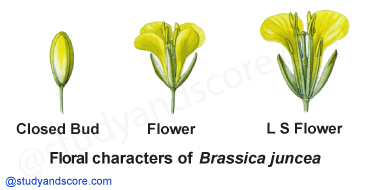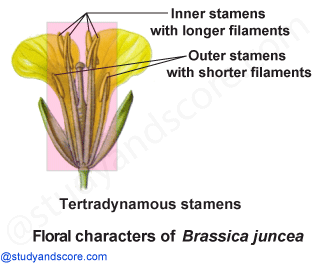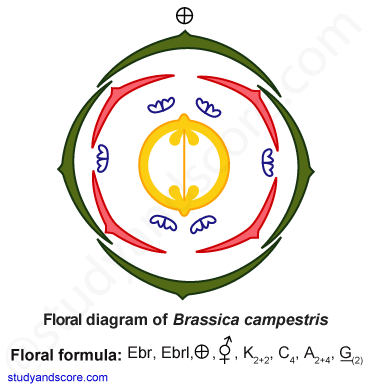Common name: Mustard family
Number of genera: This family includes 375 genera and about 3200 species.
Propagation type: Fruit, partial fruit, seed
Distribution: The species of this family are distributed throughout the world but are abundant in North Temperate Zone with Mediterranean as major center. In India this family is represented by about 51 genera and 138 species distributed around temperate and alpine Himalaya. Some are also found in plains of Northern India and hills of south India.

Habitat: Members of this family are mostly mesophytes.
Habit: The members of this family are primarily herbaceous. These herbs may be mostly annual or perennial or rarely biennials.
Root system: The members of this family have tap root system. This root system become fleshy in come cultivated species like Raphanus sativus.
Stem: Stem is usually soft, slender covered with branched stellate, unicellular hairs. Few biennial members produce rosette of radical leaves in first year and the flowering shoot in the second year. These plants are often known to contain pungent smelling watery juice. Another most common feature of this family is the presence of glandular, simple stellar hairs.
Leaf: Leaves are simple, entire, pinnate, exstipulate and pinnatifid or pinnatisect. The leaves may be cauline or radicle. Cauline leaves alternate or rarely opposite arrangement.
Inflorescence: It is usually racemose or corymb type. It may be simple or sometimes branched. In corymb (Iberis) inflorescence the bracts and bracteoles are usually suppressed.
Flower: The flowers complete, hermaphrodite, actinomorphic or sometimes zygomorphic (Iberis). Flowers may be tetramerous and hypogynous.

Calyx: The calyx consists of 4 sepals which are free and imbricate in nature. The two outer lateral sepals are often larger and saccate at the base whereas the inner two sepals are usually slimmer.

Corolla: The corolla consists of 4 distinct, diagonally placed petals. Petals are usually long-clawed. In Iberis corolla is zygomorphic. Two anterior petals are much larger than the posterior petals. Petals are rarely absent as in case of Coronopus.
Androecium: Stamens are six in number which are tetradynamous. The filaments of the two inner pairs of stamens are occasionally connate. Sometimes as in Alyssum, the filaments are winged or with tooth like appendages. Anthers are dithecous, introse and open lengthwise. Some species have four stamens (Nasturium) and some have only two lateral stamens (Didymus).
*Tetradynamous- Two outer stamens are opposite to the lateral sepals and four inner stamens are opposite to the petals. Inner stamens have longer filaments than the outer stamens.
Gynoecium: Gynoecium consists of bicarpellary, syncarpous, superior ovary. Ovary has two parietal placentae each with one or many ovules. A false septum extending from one parietal placenta to the other divides the cavity of the ovary into two locules. The style is simple or absent. Stigma is two lobed or discoid.

Pollination: The members of this family are both self-pollinated and insect pollinated. As the flowers are very small, the nectar is not easy available. So the flowers can only be visited by few small insects.
Fruit: The fruit is a pod which dehisces by two valves, break away from below upwards. Seeds remain attached to the persistent placentae. If the pod is cylindrical it is called siliqua (Brassica sps.) and if the pod is short and broad it is called siliqcula (Alyssum). The fruits of this family have importance in taxonomic and systematic studies.
Seed: The seeds are small, non-endospermic with curved embryo. The cotyledons are large incumbent, Accumbent or folded. Seeds are dispersed by birds, cattle, wind or water.
*Incumbent- The radicle is turned up on the back of one cotyledon
*Accumbent- Radicle is facing the edges of both cotyledons
The following is a list of some important members of family Brassicaceae, arranged alphabetically.
Alyssum (Basket of gold)
Arabis (Rock cress)
Brassica campestris (Mustard)
Brassica alba (White mustard)
Brassica juncea (Indian mustard)
Brassica napus (Rape seed)
Brassica nigra (Black mustard)
Brassica rapa (Turnip)
Brassica oleracea gongylodes (Knol-khol)
Brassica oleracea capitata (Cabbage)
Brassica oleracea gemmifera (Brussels sprouts)
Brassica oleracea botrytis (Cauliflower)
Capsella bursa
Chieranthus cheri (Wall flower)
Eruca sativa (Taramir)
Iberis amara (Candy tuft)
Mathiola incana (Stocks)
Raphanus sativus (Radish)
Family Brassicaceae is also called as the mustard family. This family includes 375 genera and about 3200 species. The members of this family are distributed throughout the world. Its members yield several vegetable crops.
1. Vegetable yielding plants
2. Fatty Oil yielding plants
3. Cattle feed and fodder
4. Seeds of Brassica nigra and Brassica alba are also used as condiment.
5. Medicinal plants
6. Ornamental plants
Hope you have liked this post.
Please share it with your friends through below links.
All the very best from Team Studyandscore
“Study well, Score more…”
- Share with your friends! -
Login to post your comment here...
- or with social Account -